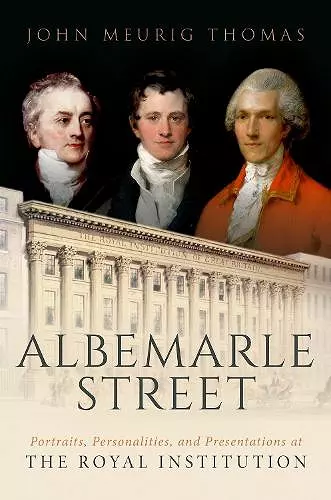Albemarle Street
Portraits, Personalities and Presentations at The Royal Institution
Format:Hardback
Publisher:Oxford University Press
Published:5th Oct '21
Currently unavailable, and unfortunately no date known when it will be back

The Royal Institution of Great Britain is renowned the world over, first, because it is a premier arena for the advancement of new scientific and technological knowledge; and second because it highlights the advance of knowledge of all kinds. It bridges the sciences and the humanities, and as much publicity is given to advances in the arts, archaeology, architecture, drama and literature as to the pure and applied sciences. More famous scientists have lived and worked in the Royal Institution than in any other laboratory in the world. A roll-call includes Rumford, Davy, Faraday, Tyndall, Dewar, Rayleigh, W. H. Bragg, W. L. Bragg and George Porter. Not is it only the home of continuous electricity, it is also the birthplace of many aspects of molecular biology and viruses and enzymology. Some fifteen scientists who have won the Nobel Prize have, at one time or another, worked or lectured at the RI. And eminent individuals, like Howard Carter and Coleridge, have lectured there. Albemarle Street - Portraits, Personalities and Presentations at The Royal institution is a lively and compelling personal selection of the remarkable personalities and achievements of some of the extraordinary scientists and individuals who, during the nineteenth and twentieth centuries, worked or lectured at 21 Albemarle Street in Mayfair, central London. John Meurig Thomas offers a unique and valuable insight into the history of this prestigious address, having himself lived and worked at the Royal Institution for some twenty years.
The publisher spared no expense in obtaining high--quality color reproductions of portraits and photos relating to TRI. Thomas intended the book as a popular treatment rather than a scholarly history. Although the text is annotated by footnotes, most of the material is drawn from secondary sources such as obituaries, and historians will find it more entertaining than illuminating. That said, for conveying what TRI is all about and documenting the scope and variety of famous people who passed through its doors over the years, this book has no peer. * K. D. Stephan, Texas State University, CHOICE *
It is a delight to read, beautifully written, and is both a historical and personal chronicle of an institution that was and still remains a mecca of science communication in Britain. * Arpan K. Banerjee, Hektoen International Journal *
The Royal Institution is a national treasure, a jewel in Britain's scientific crown. Nobody is better qualified to tell its historic story than its former Director, Sir John Meurig Thomas. His book will delight all who care about science and its history. * Richard Dawkins *
John Meurig Thomas's writing style is lively and accessible - portraying a range of distinguished and idiosyncratic characters. It would be hard to think of any author who could do a better job of portraying these people's lives and achievements for a wide readership - conveying what it was like to be a scientist, and what their role in society was. * Lord Martin Rees, Cambridge University *
There is no place in London which has housed such talent and adventurous exploration of the world as The Royal Institution. The retelling in context of unusual and pivotal RI discourses, such as that of Grove on the fuel cell, Andrew on MRI, is a very strong feature of the book. The excursions on potentially the most famous experiments and Egyptomania are really fun. * Roald Hoffmann, Nobel Laureate, Cornell University *
Reading it is effortless and compelling. The author has a style that is absent in many writers today and he keeps the reader interested. * Peter Dobson, Oxford University *
This is a high-quality book, written by a master craftsman in words. The chapters are packed full of useful and interesting information that I have not come across before. It is a fascinating book to read. * Sir Colin Humphreys, Cambridge University *
A wonderful book - The Royal Institution has been a very special place, with a remarkable cast of characters: Count Rumford, Humphry Davy, Michael Faraday, Thomas Young… Sir John is the perfect person to write about it. * Lubert Stryer, Stanford University *
A gem akin to his Architects of Structural Biology book, and very likely to draw a wide potential readership. * Dudley Herschbach, Nobel Laureate, Harvard University *
Many of the anecdotes are indeed interesting, informative, and illuminating â and from time to time amusing...every scientist should get something really interesting and enjoyable from reading what must have been one of the last things John Meurig Thomas wrote. * John Finney, Crystallography News *
The book is illustrated with both black-and-white and color photos. It is a delight to read, beautifully written, and is both a historical and personal chronicle of an institution that was and still remains a mecca of science communication in Britain. * Arpan Banerjee, Hektoen International Journal *
ISBN: 9780192898005
Dimensions: 240mm x 164mm x 20mm
Weight: 632g
284 pages